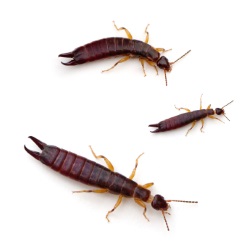Biology:
 The name of the earwig comes from a European superstition that they enter the ears of a person sleeping and bore themselves into the brain. However, studies have shown that this superstition is completely false.
The name of the earwig comes from a European superstition that they enter the ears of a person sleeping and bore themselves into the brain. However, studies have shown that this superstition is completely false.
"There is no truth to this myth," writes John Meyer, professor of entomology at North Carolina State University.
"Though they may try to pinch if captured and handled, they do not harm people," confirms the Iowa State University Dept. of Entomology.
The forceps, or "pinchers," found at the end of the abdomen are used as offensive and defensive weapons. Some predator species use them to capture prey, while others can pinch human skin if they are being handled and are not known to spread disease. Other than their pinchers, they are also known for their repulsive odor when squished, and some species can even release the liquid willingly. Earwigs can be found worldwide, and there are roughly 22 species of earwigs in the United States. The most commonly sited earwigs in the U.S. are: the European Earwig, the Red-Legged Earwig, and the Striped Earwig.
The European Earwig is a dark, reddish brown color with a red head and pale wings, legs, and antennaes. The Red-Legged Earwig are dark brown and/or black with a yellowish brown undersurface and are wingless but do have antennaes. The Striped Earwig varies from pale brown with dark markings to chesnut or reddish brown with both pale and dark markings. All three typically remain outdoors and underground in groups, and depend on moist soil to survive.
Reproduction & Stages:
Females will lay their eggs underground and tend to them in their nymph stage. The European Earwig female will lay about 30-55 eggs in it's first batch, and the number will decrease with the more batches it lays. The Red-Legged female lays about 40-53 eggs on average. The Striped Earwig female can lay up to 50 eggs the first time. and can lay about 3 to 4 more batches. After they hatch they begin the nymphal stage, then grow into the adult stage.
Habits:
Earwigs are nocturnal insects and usually hide during the day underground in moist, shady areas such as under stones, logs, and mulch. They feed on live or dead plants and, depending on the species, other insects. The European Earwig can damage vegetables, flowers, fruits, shrubs, trees, and even can feed off the honey in beehives. The Red-Legged Earwig is recorded to have been found in Irish and sweet potatoes in storage, greenhouses and nurseries, flour mills, breweries, and meat-packing plants. However, the Striped Earwig is not recorded as a threat to plants.
Earwigs are incredibly good climbers and crawl up walls and tree branches that are close to houses. Houses with shake roofs are especially at risk for an earwig infestation. Shake roofs are usually dark and damp, an ideal nesting site for them. They can enter the structure of the home through the cracks and penetrations. They are also attracted to lights and other insects attracted to lights. The European and Red-Legged Earwig are usually the species that invade homes by the hundreds and thousands.
Control:
There are things you can do to help prevent an earwig infestation. Remove unessential mulch, plant debris, and objects such as stones and boards from around the structure of the home. This creates a low-moisture zone that earwigs cannot reside in. If you do find yourself in an uncontrollable situation, you can call or email us to set up a free estimate and evaluation.

